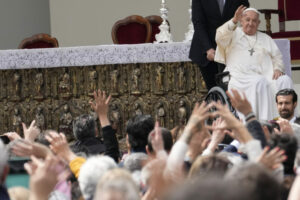The Middle East’s favorite sweet symbolizes Good Friday. Maamoul is a buttery cookie baked with semolina and stuffed with dates or nuts—usually walnuts or pistachios. Seasoned with a variety of spices, for centuries it has flavored the Easter holiday for Christians, the end of Ramadan for Muslims, and Purim for the Sephardic Jews of Jerusalem. Three shapes are common: an elongated oval, a circular ring, and a rounded dome. Patterns are pressed into the dough by tweezer or with a traditional wooden mold, often in the shape of a sunburst and sometimes with a cross. For Christians, the oval resembles the sponge given to Jesus to drink from. The ring, his crown of thorns. And the dome is shaped like his rock-hewn tomb, sealing its scented treasure within.
“Is that so?” asked Hoda Khoury, a Lebanese mother of three adult children, hard at work preparing the sweet. “That’s nice. That would make maamoul a Christian tradition.” Not all believers know the deeper meaning. Recipes vary, as do the names. Called kakh in Egypt, kleicha in Iraq, and kombe in southeast Turkey, experts have differing opinions on the cookie’s origin. Many find traces of Pharaonic or Mesopotamian beginnings, some suggesting the imprinted patterns reflect ancient worship of the sun. Charles Perry, translator of the medieval Baghdad Cookery Book, says maamoul descends from the Persian kulachag, perhaps reflected in the Iraqi name today. Lebanese historian Charles El Hayek suggests the cookie may have originated in the Neolithic period but that the modern sharing of the sweet began in Fatimid Egypt (A.D. 909–1171).
Ultra-modern is the chocolate filling—promoted by Hershey’s Middle East. But the tradition of maamoul distribution began in Cairo, Hayek said, when the Islamic caliph ended the Muslim month of fasting by giving cookies to the masses on Eid al-Fitr, stamped with the phrase “eat and be grateful.” Some were even stuffed with gold coins. Eventually the royal generosity was taken over by domestic households, and Hayek believes the modern maamoul recipe developed during the period of Ottoman rule over the Levant. Khoury continues the tradition today. Imitating her grandmother, she does double duty with the dough. The first batch of a few hundred maamoul reflects their life in Beirut, the recipe learned from neighbors when her grandfather moved the family to the capital in 1925, long before Khoury was born.
The second batch of a few hundred akraas—a similar half-moon–shaped sweet from her ancestral hamlet of Maghdouche—reflects the diversity of the Middle East’s many religious communities. The Greek Catholic town only 30 miles south of Beirut did not have maamoul at all. Perhaps this is why she did not know the Good Friday symbolism. But the great quantity she bakes is measured out carefully. “If we make too much, we have to eat them ourselves—and they are not very healthy,” Khoury said. “But we don’t mind tiring ourselves out; homemade is much more delicious.” The Arabic word for maamoul means “made.” Arab hospitality welcomes neighbors, friends, and relatives for the exchange of mutual visits during Holy Week—Muslim and Christian alike. Two full days of cooking are necessary to prepare enough to go around; her son helps knead the dough and her sister stuffs in its contents. Khoury’s daughter is in Dubai, and though she is a talented cook, her mother fears the practice will die out with this current generation.
As do many older Jordanians. Suheil Madanat was born in Jerusalem in 1959, the son of a Christian and Missionary Alliance pastor in the old city. He looked forward to maamoul every Easter, but after moving to his native Jordan in 1976 he cringed as the tradition commercialized. Sweet shops opened everywhere, even as modern city life eroded village values. Fewer and fewer visits were exchanged, and today many might only stop by to see their parents. Formerly head of the Baptist Convention of Jordan, Madanat blames the spirit of individualism that is spreading around the world. He also laments that many Christians neglect the symbolism of maamoul. “The stories abound,” Madanat said. “But people are more interested in eating than in understanding.” Connections between the cookie and the crown of thorns are emphasized by Orthodox priests, he said, in line with their use of icons. Evangelicals focus on the spiritual truth and the historical account. Muslims, meanwhile, associate maamoul with no symbolism at all, as Islam denies the crucifixion of Jesus. All are equally enamored with the taste, but the Orthodox are on to something. “I think we need a combination,” Madanat said. “Anything you can touch, smell, and eat can become a tangible reminder.”
And for Nabil Shehadi, coordinator for the Alpha course in the Levant region, it could be a means of interfaith dialogue. He has not heard of a maamoul ministry, but thinks it would be a good idea. As former vicar of All Saints’ Anglican Church in Beirut, he agrees that evangelicals tend to lack an incarnational spirituality that is more associated with liturgical traditions. The heavens declare the glory of God, he quoted, and everything in the world is meant to do the same. Specifically, he wants a high theology of maamoul. “Any food is a good bridge for bringing people together,” said Shehadi. “Imagine the impact on our Christian community if—like Muslims—we ate together every day for a month and invited our neighbors in.” They could then tell the story of Easter via dessert, he said. Muslims break fast during Ramadan at sunset, often in a communal setting. Food blogger Sawsan Abu Farha said that it is uncertain how maamoul became linked with Easter and Eid al-Fitr. A Palestinian Muslim, she stated that one theory posits the “bland” outer shell represents the hard work of fasting during Lent and Ramadan but that inside, a “sweet reward” awaits. And even with Purim, Queen Esther’s hidden Jewish identity was the “rich filling” inside a “dainty pastry.”












































